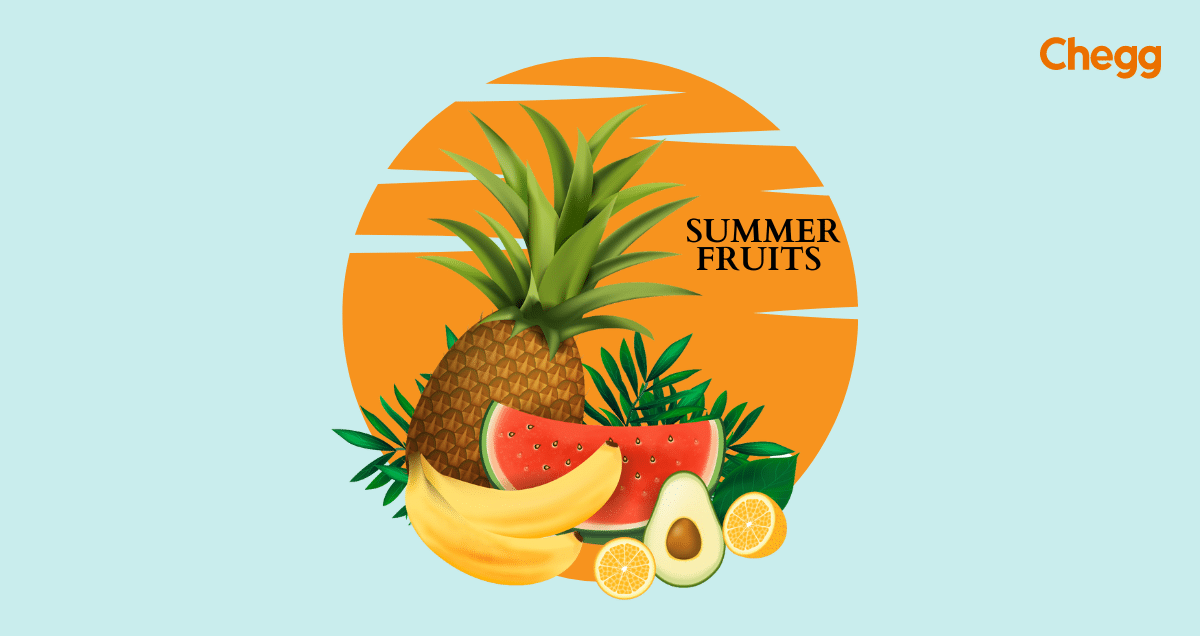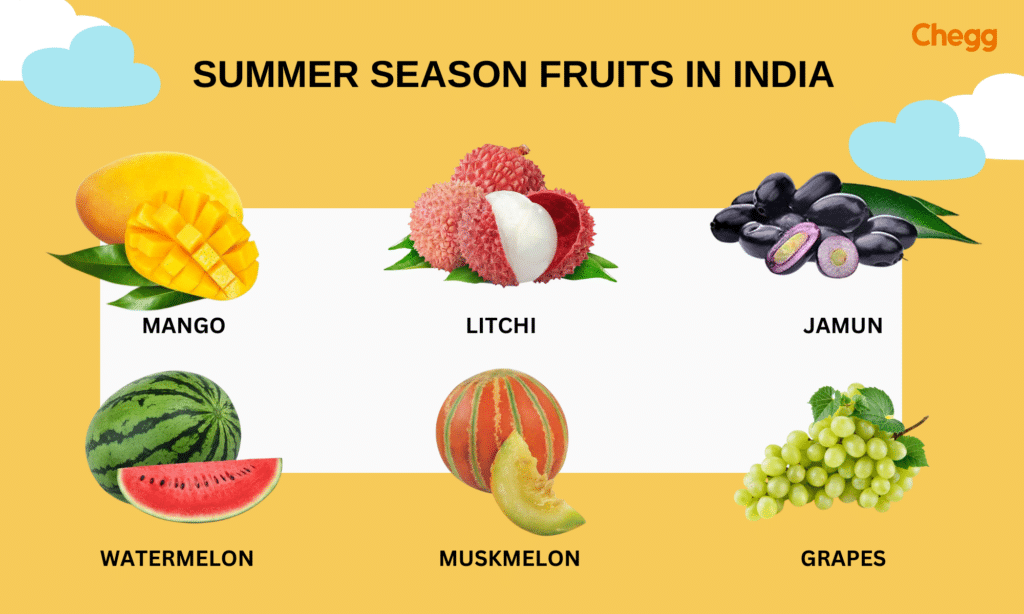15 Delicious Summer Season Fruits in India: A Complete Guide with Nutrition Facts


Quick Summary
-
Summer season fruits in India are Mango (Aam), watermelon (Tarbooz), lychee (Litchi), and jackfruit (Kathal) are popular favorites during this time. Other refreshing fruits include pineapple (Ananas), papaya (Papita), blackberry (Jamun), muskmelon (Kharbooja), cucumber (Kheera), plum (Aloo Bukhara), apricot (Khubani), strawberry, fig (Anjeer), starfruit (Kamarakh), and coconut (Nariyal).
-
they help keep you hydrated, and boost immunity during the hot Indian season.
-
Eating summer fruits regularly aids digestion, keeps you cool, and provides essential nutrients to stay healthy in the heat.
Table of Contents
Summer season fruits in India are a celebration of flavor, color, and nutrition. As temperatures soar from March to June, these juicy delights offer a refreshing respite from the heat. From the king of fruits, mango, to hydrating watermelons and muskmelons, summer season fruits in India provide a delicious way to stay cool. Thanks to the country’s diverse climate, summer season fruits in India include a wide range of options such as lychees, jamun, and papayas, each packed with unique health benefits. Embrace the vibrant tastes and wholesome goodness of summer season fruits in India to make the most of the season.
From the nationally beloved mango to the hydrating watermelon, these seasonal treats are more than just snacks – they’re an integral part of Indian culture and cuisine. Packed with vitamins, minerals, and antioxidants, summer season fruits in India provide a natural way to stay healthy and hydrated during the hottest months. From juicy lychees and refreshing muskmelons to the tangy taste of jamun, summer season fruits in India offer a variety of flavors to enjoy.
Adding to the list are the succulent papayas and zesty pineapples, making summer season fruits in India a perfect choice to beat the heat. Embrace the wholesome goodness of summer season fruits in India and celebrate the vibrant tastes of the season.
In this guide, we’ll explore 15 most popular summer season fruits in India, delving into their nutritional profiles, selection tips, and creative ways to enjoy them. Whether you’re a fruit enthusiast, a health-conscious individual, or simply curious about Indian seasonal produce, this comprehensive look at fruits in summer season in India has something for everyone. Let’s follow us on this juicy journey through India’s summer fruits basket!

List of Summer Season Fruits in India
- Mango (Aam)
- Watermelon (Tarbooz)
- Lychee (Litchi)
- Jackfruit (Kathal)
- Pineapple (Ananas)
- Papaya (Papita)
- Blackberry (Jamun)
- Muskmelon (Kharbooja)
- Cucumber (Kheera)
- Plum (Aloo Bukhara)
- Apricot (Khubani)
- Strawberry
- Fig (Anjeer)
- Starfruit (Kamarakh)
- Coconut (Nariyal)
Let’s explore these summer season fruits in India one-by-one in detail. From the refreshing mango to the cooling watermelon, summer season fruits in India offer a variety of flavors and health benefits that are perfect for the hot months. Each fruit brings its unique taste and nutritional value, making them an essential part of the summer experience in India.
1. Mango (Aam)
Known as the ‘King of Fruits’ in India, the mango is perhaps the most beloved summer fruit in the country. With its sweet, juicy flesh and rich aroma, it’s no wonder that mangoes are eagerly awaited each year.
- Peak availability: May to July.
- Nutritional highlights: Rich in Vitamins A and C, which are great for your eyes and immune system. Good source of dietary fiber, helping with digestion.
- Unique fact: India grows over 1000 varieties of mangoes, each with its own unique flavor and texture.
Mangoes are incredibly versatile. You can enjoy them fresh, add them to smoothies, use them in desserts, or even in savory dishes like mango curry. The Alphonso mango from Maharashtra is particularly famous for its sweetness and is often considered one of the best varieties in the world.
2. Watermelon (Tarbooz)
Nothing says summer quite like a slice of cool, refreshing watermelon. This large, juicy fruit is a favorite at picnics and beach outings across India.
- Peak availability: April to June.
- Nutritional highlights: Very low in calories, making it great for weight watchers. Contains lycopene, a powerful antioxidant that may help protect against certain types of cancer.
- Unique fact: Watermelon is 92% water, making it an excellent choice for staying hydrated in the summer heat.
Watermelon is usually eaten fresh, often sprinkled with a bit of chaat masala for a tangy twist. It’s also great in fruit salads or blended into a refreshing juice. Some people even enjoy the seeds, which are packed with nutrients!
3. Lychee (Litchi)
These small, round fruits with bumpy red skin are a true summer delicacy. Once you peel off the thin skin, you’ll find translucent white flesh with a delicate floral flavor.
- Peak availability: May to July.
- Nutritional highlights: High in Vitamin C, even more than oranges! Contains good amounts of potassium, which is important for heart health.
- Unique fact: Lychees have been cultivated in China for over 2000 years and were introduced to India in the 18th century.
Lychees are usually eaten fresh, but they’re also great in desserts or as a flavoring for drinks. In some parts of India, they’re even used to make wine! Be careful not to eat too many at once, though, as they can cause a bit of a sugar rush.
4. Jackfruit (Kathal)
Jackfruit is the largest tree-borne fruit in the world and has a spiky green exterior. Don’t let its intimidating appearance fool you – inside, you’ll find yellow, fleshy bulbs that are sweet and flavorful.
- Peak availability: March to June.
- Nutritional highlights: Rich in Vitamin B6, which helps your body convert food into energy. Good source of potassium and fiber.
- Unique fact: Jackfruit is often used as a meat substitute in vegetarian and vegan dishes due to its texture when cooked.
In India, jackfruit is enjoyed both ripe and unripe. Ripe jackfruit is sweet and often eaten fresh or used in desserts. Unripe jackfruit, on the other hand, is used in savory dishes like curries and biryanis. The seeds are also edible and can be roasted like nuts.
5. Pineapple (Ananas)
While pineapples aren’t native to India, they’ve become a popular summer fruit, especially in the southern and northeastern states.
- Peak availability: March to July.
- Nutritional highlights: Excellent source of Vitamin C and manganese. Contains bromelain, an enzyme that can aid digestion.
- Unique fact: Despite its name, a pineapple is actually a group of many seasonal fruits fused together.
Pineapples are great eaten fresh, grilled, or added to fruit salads. They’re also a key ingredient in many sweet and sour dishes in Indian cuisine. In some parts of India, pineapple curry is a popular dish!
6. Papaya (Papita)
Papaya, with its soft, orange flesh and small black seeds, is a fruit that’s available year-round in India but is especially refreshing in the summer. It pairs perfectly with other summer season fruits in India like mangoes and watermelons, both of which are packed with hydration and nutrients. These summer season fruits in India are not only delicious but also offer a natural way to cool down during the hot months.
- Peak availability: March to July.
- Nutritional highlights: Rich in Vitamins A and C. Contains papain, an enzyme that aids digestion.
- Unique fact: In India, papaya leaves are sometimes used to make tea, which is believed to help boost platelet count in dengue fever patients.
Ripe papaya is usually eaten fresh or added to fruit salads. Green, unripe papaya is used in salads, particularly in Thai-inspired dishes. The seeds, which have a peppery taste, can be dried and used as a spice.
7. Blackberry (Jamun)
Jamun, also known as Java plum or black plum, is a small, dark purple fruit with a sweet and slightly tart flavor.
- Peak availability: May to July.
- Nutritional highlights: Rich in antioxidants, which help protect your cells from damage. Contains iron and vitamin C.
- Unique fact: Jamun is believed to be beneficial for people with diabetes as it may help regulate blood sugar levels.
Jamun is usually eaten fresh, often sprinkled with a little salt to enhance its flavor. It’s also used to make jams, jellies, and even wine in some parts of India. The seed powder is used in Ayurvedic medicine.
8. Muskmelon (Kharbooja)
Muskmelon, also known as kharbuja in Hindi, is a sweet, aromatic fruit that’s a close relative of the cantaloupe.
- Peak availability: April to June.
- Nutritional highlights: High in Vitamins A and C. Good source of potassium.
- Unique fact: Muskmelons are actually a type of berry, botanically speaking.
Muskmelons are usually cut into slices and eaten fresh. They’re also great in fruit salads or blended into smoothies. In some parts of India, the seeds are dried and eaten as a snack.
9. Cucumber (Kheera)
While often thought of as a vegetable, cucumber is botanically a fruit. It’s a cool, crisp addition to any summer meal.
- Peak availability: Year-round, but especially refreshing in summer.
- Nutritional highlights: Very low in calories. High water content, great for hydration.
- Unique fact: Cucumbers are part of the same plant family as melons and squashes.
In India, cucumbers are often eaten raw as a snack or added to salads. They’re also a key ingredient in raita, a cooling yogurt-based side dish. In some regions, cucumber juice is popular as a refreshing summer drink, just like other summer season fruits in India such as mangoes and watermelons, which are perfect for staying hydrated during the heat. These summer season fruits in India not only refresh but also provide essential nutrients to keep you healthy throughout the summer.
10. Plum (Aloo Bukhara)
Plums come in various colors, from deep purple to red to yellow, and have a sweet-tart flavor.
- Peak availability: May to August.
- Nutritional highlights: Good source of vitamins C and K. Contains antioxidants that may help improve bone health.
- Unique fact: Dried plums are known as prunes and are famous for their digestive health benefits.
Plums are usually eaten fresh but are also used in jams and chutneys. In some parts of northern India, a spicy-sweet plum sauce is a popular condiment.
11. Apricot (Khubani)
Apricots are small, golden fruits with a sweet-tart flavor and a soft, velvety skin.
- Peak availability: May to July.
- Nutritional highlights: Rich in Vitamins A and C. Good source of fiber and potassium.
- Unique fact: In Ladakh, sun-dried apricots are a traditional way to preserve the fruit for the harsh winter months.
Fresh apricots are delicious on their own or added to fruit salads. They’re also used in jams, preserves, and even in some savory dishes in Indian cuisine.
12. Strawberry
While not traditionally a summer fruits in most of India, strawberries are grown in hill stations and are available in markets during the early summer months.
- Peak availability: February to April in most regions, extending into early summer in some hill stations.
- Nutritional highlights: High in Vitamin C. Contains antioxidants and fiber.
- Unique fact: Strawberries are the only fruit with seeds on the outside.
Strawberries are often eaten fresh, used in desserts, or made into jams. In India, they’re sometimes added to fruit chaat (spicy fruit salad) for a unique twist.
13. Fig (Anjeer)
Figs are sweet, soft fruits with a unique texture due to their tiny, crunchy seeds.
- Peak availability: June to September.
- Nutritional highlights: Good source of fiber and potassium. Contains calcium, which is important for bone health.
- Unique fact: Figs are actually inverted flowers and not technically a fruit!
In India, figs are often eaten fresh or dried. They’re also used in traditional medicine and are believed to have various health benefits. Fig preserves and chutneys are popular in some regions, along with other summer season fruits in India like mangoes and watermelons, which are enjoyed for their refreshing taste and hydrating qualities. These summer season fruits in India not only add flavor to dishes but also provide essential nutrients during the hot months.
14. Starfruit (Kamarakh)
Starfruit, named for its distinctive shape when cut crosswise, has a crisp texture and a sweet-tart flavor.
- Peak availability: May to September.
- Nutritional highlights: Low in calories. Good source of Vitamin C and fiber.
- Unique fact: In India, starfruit is sometimes called kamrakh or kamaranga.
Starfruit is usually eaten fresh, often sliced and added to fruit salads. It’s also used to make juices and preserves. In some parts of India, it’s used in pickles and chutneys, along with other popular summer season fruits in India like mangoes and watermelons, which are enjoyed for their refreshing taste and nutritional value. These summer season fruits in India are not only delicious but also help keep you hydrated and energized during the hot summer months.
15. Coconut (Nariyal)
While available year-round, coconuts are especially refreshing in the summer months.
- Peak availability: Year-round, but especially popular in summer.
- Nutritional highlights: Rich in healthy fats. Good source of minerals like manganese and copper.
- Unique fact: In India, coconuts are often used in religious ceremonies and are considered sacred in Hindu culture.
Young coconuts provide refreshing water and soft, jelly-like flesh. Mature coconuts have firmer flesh that’s used in cooking, baking, and making coconut milk. Coconut water is a popular natural electrolyte drink, perfect for hot summer days.

What are the health benefits of eating summer fruits?
Summer fruits are not just refreshing; they are packed with essential vitamins, minerals, and antioxidants that are vital for your health, especially during the hot season. Here are the key benefits of adding them to your diet:
- Hydration: Many summer fruits, like watermelon and musk melon, have high water content, keeping you hydrated in the scorching heat.
- Rich in Nutrients: Summer Fruits like mango and lychee are packed with essential vitamins such as A and C, which are great for overall health.
- Boosts Immunity: Vitamin C-rich fruits, like lychee and jamun, help strengthen your immune system, protecting you from infections.
- Aids Digestion: Fruits like papaya and pineapple are rich in digestive enzymes like papain and bromelain, which promote healthy digestion.
- Cooling Effect: Most summer fruits have a natural cooling effect on the body, making them perfect for hot Indian summers.
Remember, while fruits are healthy, they should be part of a balanced diet. It’s always a good idea to enjoy a variety of summer season fruits in India to get a wide range of nutrients. Incorporating popular summer season fruits in India like mangoes, watermelons, and lychees into your diet can help you stay refreshed and energized. Along with their hydrating properties, summer season fruits in India are rich in essential vitamins and minerals, making them a perfect addition to your meals. To maximize health benefits, try different combinations of summer season fruits in India and enjoy the delicious flavors of the season.
Adding to the list are the succulent papayas and zesty pineapples, making summer season fruits in India a perfect choice to beat the heat. Embrace the wholesome goodness of summer season fruits in India and celebrate the vibrant tastes of the season.
How to Choose and Store Summer Fruits?
Choosing ripe, fresh fruits and storing them properly can help you enjoy them at their best. Here are some general tips:
- Use Your Senses: Look for fruits with vibrant colors and pleasant aromas. Avoid fruits with bruises, soft spots, or signs of mold.
- Feel the Fruit: Many fruits should yield slightly to gentle pressure when ripe.
- Consider Weight: For fruits like melons, a heavier weight often indicates more juice.
- Check the Stem: For fruits like mangoes and avocados, a fresh-looking stem often indicates freshness.
Here’s a table with specific storage tips for our summer fruits:
| Fruit | Storage Method | Shelf Life |
|---|---|---|
| Mango | Room temperature until ripe, then refrigerate | 5-7 days |
| Watermelon | Room temperature until cut, then refrigerate | 3-5 days (cut) |
| Lychee | Refrigerate in a plastic bag | 5-7 days |
| Jackfruit | Room temperature until ripe, then refrigerate | 3-5 days (cut) |
| Pineapple | Room temperature if eating soon, otherwise refrigerate | 3-5 days |
| Papaya | Room temperature until ripe, then refrigerate | 5-7 days |
| Jamun | Refrigerate in a covered container | 2-3 days |
| Muskmelon | Room temperature until ripe, then refrigerate | 3-5 days (cut) |
| Cucumber | Refrigerate in a plastic bag | 1 week |
| Plum | Refrigerate | 3-5 days |
| Apricot | Refrigerate when ripe | 3-5 days |
| Strawberry | Refrigerate, unwashed, in a single layer | 3-5 days |
| Fig | Refrigerate | 2-3 days |
| Starfruit | Refrigerate when ripe | 3-5 days |
| Coconut | Room temperature if whole, refrigerate if cut | 1 week (cut) |
Remember, these are general guidelines. Always use your best judgment and consume summer season fruits in India before they spoil to enjoy their peak freshness. Whether it’s the juicy mangoes or the hydrating watermelons, make sure to enjoy summer season fruits in India when they’re at their best.
Keep an eye on the ripeness of your summer season fruits in India, like lychees and muskmelons, to make the most of their delicious flavors. Proper storage can help extend the shelf life of summer season fruits in India, so you can savor them throughout the season.
Simple Summer Fruit Recipes
Enjoying summer season fruits in India doesn’t always mean eating them plain. Here are some simple, delicious recipes you can try with your favorite summer season fruits in India. Whether it’s a refreshing fruit salad, a chilled smoothie, or a tangy chutney, these fruits can be transformed into delightful dishes that will help you beat the heat and enjoy the flavors of summer.
1. Mango Lassi
A cool, refreshing drink perfect for hot summer days, which save us from heat wave.
1.1. Ingredients:
- 1 ripe mango, peeled and chopped
- 1 cup plain yogurt
- 1/2 cup milk
- 2 tablespoons honey (adjust to taste)
- A pinch of cardamom powder
- Ice cubes
1.2. Steps:
- Blend all ingredients until smooth.
- Pour into glasses and serve chilled.
2. Watermelon Mint Cooler
A hydrating drink that’s both sweet and refreshing.
2.1. Ingredients:
- 3 cups chopped watermelon
- 10-12 fresh mint leaves
- 1 tablespoon lemon juice
- 1 cup cold water
- Ice cubes
2.2. Steps:
- Blend watermelon, mint leaves, lemon juice, and water until smooth.
- Strain if desired, add ice, and serve immediately.
3. Mixed Fruit Chaat
A tangy and spicy fruit salad that’s a popular street food in India.
3.1. Ingredients:
- 2 cups mixed chopped fruits (mango, apple, pineapple, cucumber, pomegranate seeds)
- 1 tablespoon lemon juice
- 1/2 teaspoon chaat masala
- 1/4 teaspoon roasted cumin powder
- A pinch of black salt (kala namak)
- 2 tablespoons finely chopped mint leaves
3.2. Steps:
- Mix all the chopped fruits in a large bowl.
- Add lemon juice, chaat masala, cumin powder, and black salt. Toss gently.
- Sprinkle with mint leaves and serve immediately.
4. Lychee Sorbet
A light and refreshing dessert perfect for summer evenings.
4.1. Ingredients:
- 2 cups lychee pulp (from fresh or canned lychees)
- 1/2 cup sugar
- 1/4 cup water
- 1 tablespoon lemon juice
4.2. Steps:
- Make a simple syrup by heating sugar and water until the sugar dissolves. Let it cool.
- Blend lychee pulp with the cooled syrup and lemon juice.
- Pour into a shallow dish and freeze for about 4 hours, stirring every hour to break up ice crystals.
- Scoop and serve.
5. Jackfruit Curry (for a savory option)
A unique way to enjoy jackfruit in a savory dish.
5.1. Ingredients:
- 2 cups young jackfruit, cut into bite-sized pieces
- 1 onion, finely chopped
- 2 tomatoes, chopped
- 2 green chilies, slit
- 1 tablespoon ginger-garlic paste
- 1/2 teaspoon turmeric powder
- 1 teaspoon red chili powder
- 1 teaspoon garam masala
- Salt to taste
- 2 tablespoons oil
- Coriander leaves for garnish
5.2. Steps:
- Heat oil in a pan. Add onions and sauté until golden brown.
- Add ginger-garlic paste and green chilies. Sauté for a minute.
- Add tomatoes, turmeric, red chili powder, and salt. Cook until tomatoes are soft.
- Add jackfruit pieces and 1/2 cup water. Cover and cook until jackfruit is tender.
- Sprinkle garam masala, garnish with coriander leaves, and serve with rice or roti.
These recipes are just a starting point. Feel free to experiment and create your own unique dishes with these delicious summer season fruits in India! Whether it’s a refreshing fruit salad or a chilled smoothie, summer season fruits in India offer endless possibilities to add flavor and nutrition to your meals.
Fruits in Season by Month in India
| Month | Fruits in Season |
|---|---|
| January | Oranges, Grapes, Apples, Papaya |
| February | Oranges, Grapes, Apples, Strawberries |
| March | Mangoes, Papaya, Watermelon, Pineapple |
| April | Mangoes, Watermelon, Lychee, Jackfruit |
| May | Mangoes, Lychee, Watermelon, Jamun |
| June | Mangoes, Lychee, Jamun, Plums |
| July | Jamun, Plums, Papaya, Pomegranate |
| August | Papaya, Pomegranate, Apples, Bananas |
| September | Bananas, Apples, Grapes, Custard Apple |
| October | Apples, Grapes, Guava, Papaya |
| November | Guava, Oranges, Grapes, Pomegranates |
| December | Oranges, Grapes, Apples, Papaya |
For more detailed information about seasonal fruits in India, visit the National Horticulture Board.
Summer season fruits in India: Conclusion
This summer, enjoy India’s wide variety of seasonal fruits, from the juicy sweetness of mangoes to the hydrating goodness of watermelons and the tangy zest of lychees. These fruits not only offer a delicious way to beat the heat but are also packed with essential vitamins, minerals, and antioxidants that enhance your health and boost immunity.
Make the most of the season by visiting local markets or browsing online stores to find the freshest summer season fruits in India. From succulent mangoes to hydrating watermelons, summer season fruits in India bring a burst of flavor and nutrition to your table. Embrace these natural delights, such as muskmelons and lychees, which are among the most popular summer season fruits in India, and enjoy their health benefits all summer long. Let summer season fruits in India be your go-to choice for staying refreshed and energized during the hottest months!
Recommended Read :-
- 👉 Everything To Know About Monsoon Season in India
- 👉 Exploring the Vibrant Palette of Rainy Season Fruits in India
- 👉 Crop Seasons in India: Rabi, Kharif and Zaid
- 👉Which is the National Fruit of India ?
- 👉 What is the National Food of India? Top Dishes, Cultural Significance & Regional Flavors
- 👉 The National Vegetable of India & its Significance
FAQs: Summer season fruits in India
Q1. Which fruits come in the summer season in India?
Popular summer fruits in India include mangoes, watermelons, muskmelons, lychees, and pineapples.
Q2. Is pomegranate a summer or winter fruit?
Pomegranate is primarily a winter fruit, but it is available in some parts of India throughout the year.
Q3. Which summer fruit in India has the highest water content?
Watermelon has the highest water content among summer fruits in India, with about 92% water. This makes it an excellent choice for staying hydrated during hot summer days.
Q4. Are there any summer fruits in India that are good for weight loss?
Yes, many summer fruits can be beneficial for weight management when consumed as part of a balanced diet. Fruits like watermelon, papaya, and jamun are low in calories and high in fiber, which can help you feel full. However, remember that overall diet and lifestyle are key factors in weight management.
Q5. Which fruit is best for summer?
The best fruit for summer is often considered to be watermelon due to its high water content, helping to keep the body hydrated.
Q6. Which summer fruits in India are rich in Vitamin C?
Several summer fruits in India are rich in Vitamin C. Some of the best sources include: Indian gooseberry (Amla), Guava, Lychee, Papaya, Pineapple. These fruits can help boost your immune system and promote healthy skin.
Q7. Can diabetics eat summer fruits?
While fruits contain natural sugars, many can be part of a healthy diet for people with diabetes when consumed in moderation. Fruits like jamun, guava, and papaya are often recommended due to their lower glycemic index. However, it’s always best to consult with a healthcare provider or a dietitian for personalized advice.
Q8. How can I incorporate more summer fruits into my diet?
There are many ways to enjoy more summer fruits:
1. Add them to your breakfast cereal or oatmeal
2. Make fruit smoothies or fresh juices
3. Use them in salads, both sweet and savory
4. Grill fruits like pineapple or peaches for a unique dessert
5. Freeze fruit pieces for a cool snack
6. Use them as toppings for yogurt or ice cream
Q9. What are the summer season fruits and vegetables in India?
Summer fruits In India like mango, watermelon, and lychee, along with vegetables like cucumber, bottle gourd, and pumpkin, help keep the body cool, hydrated, and healthy during the heat.
Got a question on this topic?





